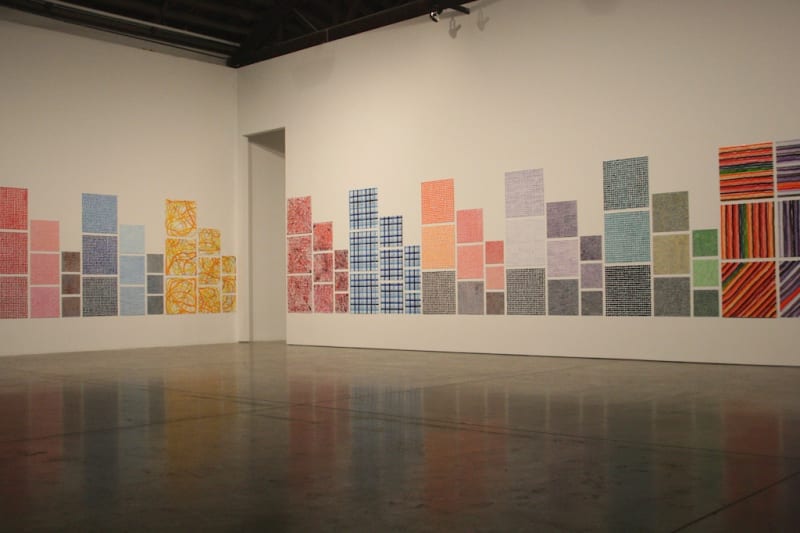BY KYLE CHAYKA
Jennifer Bartlett’s latest exhibition, called Recitative and open now at Pace Gallery, shows the artist continually breaking down and rebuilding the base particles of art. In the enormous, open gallery installation, enamel-coated steel tiles spaced in rising and falling grids line the exterior walls. Each square holds its own combination of disparate elements of art, remixing line, shape, color and texture into an infinity of combinations. This central installation, “Recitative” (2009-10), is Bartlett’s longest painting composition ever at 158 feet. What at first appears to be a gallery-size abstraction coalesces into a didactic walk-through of art at the atomic level and a joyful celebration of what it means to make a purposeful artistic mark.
“Recitative”, the namesake of this exhibition and its largest piece, continues Bartlett’s penchant for titling her major works in relation to music. The “recitation” of the title for me refers to Bartlett’s recitation of the practice of painting, a studied series of artistic gestures, simple to complex, that form an artist’s repertoire of mark-making, as a scale or a series of notes would for a musician. Within the gallery space, “Recitative” feels like an orchestrated piece of music to me, with its own measures, rhythms and crescendos. Similarly, “Rhapsody” (1975-76), a 150-foot-long series of paintings that forms one of the artist’s other major works, is meant to be read gradually, as the eye might scan sheet music. Where “Recitative” focuses on abstract mark-making, “Rhapsody” engaged with the figurative iconography of art in stanza-sections like Tree, Mountain and House.
How Bartlett creates her music is by manipulating the building blocks of visual art that I described earlier. In “Recitative,” the single steel square forms a beat in the overall composition. Each steel square has its own motif set into a grid pattern drawn onto each separate surface. Where one steel square is covered with bright orange dots, a single one in each gridded square, the steel square below it has dots of a slightly darker orange, and the third a grid of muddy green dots. In the two rows following this first set of three squares, the steel squares and patterns shrink, echoed and remixed onto smaller sets of steel squares. The overall impact is like a drum section beating out a pace for the eye to follow. Macrocosm becomes microcosm becomes macro again; no reference point for any bounded space is created by Bartlett’s painted surfaces.
This quality puts me in mind of a quote by artist Jim Lambie about his own struggle to make art that functions like music. Listening to music on headphones, the artist said, creates a space that is unbounded, an infinite space that we occupy alone with the music itself. No matter where we go, the music follows. Bartlett amps this up, going beyond Lambie’s floor-tape sculptures to create artistic music that’s full of the artist’s own hand and own sensibility. We are gently guided by Bartlett’s work to an epiphany as viewers, where Lambie’s work bounces us around to where we started.
This epiphany comes at the far right end of Bartlett’s “Recitative” in a musical measure that sees the gridded steel tiles leap out of their boundaries and align themselves helter-skelter to display an unbroken, looping curved line. In this last moment, Bartlett takes the simplest building block of art, the black line on white ground, and uses it to create the most powerful music. This is still minimalism; the economy of means that Bartlett employs is remarkable for its graceful beauty and its simplicity. But austere and hermetic this work is not- like Sol Lewitt’s wall murals, Bartlett takes the atomic particles of art, a line here, a circle there, a primary color here, a tertiary color there, and turns them into something organically sublime, an awe-inspiring mess.
In a gallery cloistered behind the enormous space of “Recitative,” a few of Bartlett’s other works are on display. These smaller series again use pre-set patterns and structures to explore what iteration means to a painter and how a single color shift can impact the overall composition of a work. These function as important background to the artist’s ideas, but the pieces are still only appetizers to the main course. Recitative is engrossing enough on its own. Trust me, you’ll want to save some time to savor it.


